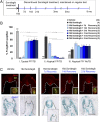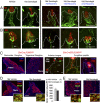Recovery of taste organs and sensory function after severe loss from Hedgehog/Smoothened inhibition with cancer drug sonidegib
- PMID: 29133390
- PMCID: PMC5715770
- DOI: 10.1073/pnas.1712881114
Recovery of taste organs and sensory function after severe loss from Hedgehog/Smoothened inhibition with cancer drug sonidegib
Abstract
Striking taste disturbances are reported in cancer patients treated with Hedgehog (HH)-pathway inhibitor drugs, including sonidegib (LDE225), which block the HH pathway effector Smoothened (SMO). We tested the potential for molecular, cellular, and functional recovery in mice from the severe disruption of taste-organ biology and taste sensation that follows HH/SMO signaling inhibition. Sonidegib treatment led to rapid loss of taste buds (TB) in both fungiform and circumvallate papillae, including disruption of TB progenitor-cell proliferation and differentiation. Effects were selective, sparing nontaste papillae. To confirm that taste-organ effects of sonidegib treatment result from HH/SMO signaling inhibition, we studied mice with conditional global or epithelium-specific Smo deletions and observed similar effects. During sonidegib treatment, chorda tympani nerve responses to lingual chemical stimulation were maintained at 10 d but were eliminated after 16 d, associated with nearly complete TB loss. Notably, responses to tactile or cold stimulus modalities were retained. Further, innervation, which was maintained in the papilla core throughout treatment, was not sufficient to sustain TB during HH/SMO inhibition. Importantly, treatment cessation led to rapid and complete restoration of taste responses within 14 d associated with morphologic recovery in about 55% of TB. However, although taste nerve responses were sustained, TB were not restored in all fungiform papillae even with prolonged recovery for several months. This study establishes a physiologic, selective requirement for HH/SMO signaling in taste homeostasis that includes potential for sensory restoration and can explain the temporal recovery after taste dysgeusia in patients treated with HH/SMO inhibitors.
Keywords: chorda tympani nerve; circumvallate papilla; fungiform papilla; taste receptor cell; taste regeneration.
Conflict of interest statement
The authors declare no conflict of interest.
Figures








Similar articles
-
Hedgehog pathway blockade with the cancer drug LDE225 disrupts taste organs and taste sensation.J Neurophysiol. 2015 Feb 1;113(3):1034-40. doi: 10.1152/jn.00822.2014. Epub 2014 Nov 12. J Neurophysiol. 2015. PMID: 25392175 Free PMC article.
-
Species generalization and differences in Hedgehog pathway regulation of fungiform and circumvallate papilla taste function and somatosensation demonstrated with sonidegib.Sci Rep. 2018 Nov 1;8(1):16150. doi: 10.1038/s41598-018-34399-3. Sci Rep. 2018. PMID: 30385780 Free PMC article.
-
Hedgehog Signaling Regulates Taste Organs and Oral Sensation: Distinctive Roles in the Epithelium, Stroma, and Innervation.Int J Mol Sci. 2019 Mar 16;20(6):1341. doi: 10.3390/ijms20061341. Int J Mol Sci. 2019. PMID: 30884865 Free PMC article. Review.
-
Probing the multimodal fungiform papilla: complex peripheral nerve endings of chorda tympani taste and mechanosensitive fibers before and after Hedgehog pathway inhibition.Cell Tissue Res. 2022 Feb;387(2):225-247. doi: 10.1007/s00441-021-03561-1. Epub 2021 Dec 3. Cell Tissue Res. 2022. PMID: 34859291 Free PMC article.
-
Sonidegib for the treatment of advanced basal cell carcinoma.Expert Opin Pharmacother. 2016 Oct;17(14):1963-8. doi: 10.1080/14656566.2016.1225725. Epub 2016 Aug 29. Expert Opin Pharmacother. 2016. PMID: 27538055 Review.
Cited by
-
Anterior and Posterior Tongue Regions and Taste Papillae: Distinct Roles and Regulatory Mechanisms with an Emphasis on Hedgehog Signaling and Antagonism.Int J Mol Sci. 2023 Mar 2;24(5):4833. doi: 10.3390/ijms24054833. Int J Mol Sci. 2023. PMID: 36902260 Free PMC article. Review.
-
The Revived Interest in Ageusia Research during the COVID-19 Pandemic: A Bibliometric Analysis.Life (Basel). 2023 Apr 21;13(4):1062. doi: 10.3390/life13041062. Life (Basel). 2023. PMID: 37109591 Free PMC article.
-
Synthesis of 2-methoxybenzamide derivatives and evaluation of their hedgehog signaling pathway inhibition.RSC Adv. 2021 Jun 28;11(37):22820-22825. doi: 10.1039/d1ra00732g. eCollection 2021 Jun 25. RSC Adv. 2021. PMID: 35480433 Free PMC article.
-
High-sucrose diet exposure is associated with selective and reversible alterations in the rat peripheral taste system.Curr Biol. 2022 Oct 10;32(19):4103-4113.e4. doi: 10.1016/j.cub.2022.07.063. Epub 2022 Aug 16. Curr Biol. 2022. PMID: 35977546 Free PMC article.
-
TrkB expression and dependence divides gustatory neurons into three subpopulations.Neural Dev. 2019 Jan 28;14(1):3. doi: 10.1186/s13064-019-0127-z. Neural Dev. 2019. PMID: 30691513 Free PMC article.
References
-
- Migden MR, et al. Treatment with two different doses of sonidegib in patients with locally advanced or metastatic basal cell carcinoma (BOLT): A multicentre, randomised, double-blind phase 2 trial. Lancet Oncol. 2015;16:716–728. - PubMed
-
- Rodon J, et al. A phase I, multicenter, open-label, first-in-human, dose-escalation study of the oral smoothened inhibitor Sonidegib (LDE225) in patients with advanced solid tumors. Clin Cancer Res. 2014;20:1900–1909. - PubMed
-
- Fife K, et al. Managing adverse events associated with vismodegib in the treatment of basal cell carcinoma. Future Oncol. 2017;13:175–184. - PubMed
Publication types
MeSH terms
Substances
Grants and funding
LinkOut - more resources
Full Text Sources
Other Literature Sources
Molecular Biology Databases
Miscellaneous

